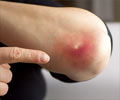Antibiotics reduce the risk of recurrent staph infection. Using antibiotics to treat staph infections prevents more infection from occurring in the future.

In the study, the researchers evaluated 383 children -- with a median age of 3 years old -- whose infections with the bacteria Staphylococcus aureus (staph) required incision and drainage. The patients also had colonization of staph in their nostrils or on their skin.
The children were evaluated for the bacteria and reinfection several times over a year; of these patients, 355 (93 percent) received antibiotics coupled with incision and drainage treatment.
A month after initial infection, bacterial swab tests found that half of the children (178) who had received antibiotics had no signs of staph living on their skin or in their nostrils, reducing the risk of recurring infection. However, the bacteria remained on the skin of about three-fourths of the children (26) who did not receive antibiotics.
Additionally, children who remained colonized with staph a month after initial infection were about twice as likely to experience a recurrent infection than those who did not have staph on their skin. That's 101 children (60 percent) compared with 54 children (30 percent).
Staph generally live harmlessly on the skin in about one-third of the human population, Fritz said. However, staph infections have become a worsening health problem, affecting not only those with weakened immune systems but otherwise healthy children and adults.
Advertisement
"In recent years, studies have demonstrated that staph infections are prominent in both hospitals and in the community," Fritz said. "For example, we have seen a dramatic increase in community-associated infections since 2000."
However, some health-care workers have hesitated prescribing antibiotics for children with minor staph infections because of increasing antibiotic resistance. The most common such strain is known as methicillin-resistant Staphylococcus aureus, or MRSA, which may cause pneumonia, severe organ damage and death. The Centers for Disease Control and Prevention reports that 11,000 adults and children die annually of MRSA infections.
Although it might seem counterintuitive, prescribing antibiotics for minor staph infections helps to reduce antibiotic resistance, said the study's first author, Patrick Hogan, a clinical research specialist at the School of Medicine. "Using antibiotics judiciously to treat staph infections eliminates staph colonization and prevents more infection from occurring in the future," he said. "This reduces the overall burden of the staph germ on the environment and people, which results in less recurrence and, therefore, less antibiotic use."
The study primarily evaluated the antibiotics clindamycin and trimethoprim-sulfamethoxazole (TMP-SMX). Of the two drugs, clindamycin was the most effective at eliminating staph colonization and preventing recurrent infection. Why clindamycin was superior to other antibiotics is unknown and warrants further study, Hogan said.
The complete study is published online in the journal Clinical Infectious Diseases.
Source-Eurekalert















